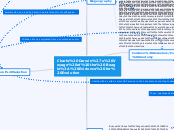Charle Darwin's Voyage of the Beagle: Evidence for Evolution
Natural Selection
Cape Verde, Porto Praya 14°N, 23°W January 16, 1832
The volcanic fires of a past age, and the scorching heat of a tropical sun, have in most places rendered the soil unfit for vegetation.
The novel aspect of an utterly sterile land possesses a grandeur which more vegetation might spoil. A single green leaf can scarcely be discovered over wide tracts of the lava plains; yet flocks of goats, together with a few cows, contrive to exist.
Volcanic activity led animals with favourable characteristics to survive, while others that didn't died.
Rio de Janeiro, Brazil: 23°S, 43°W July 5th, 1832
One day a great shoal of porpoises, many hundreds in number. The whole sea was in places furrowed by them; and a most extraordinary spectacle was presented, as hundreds, proceeding together by jumps, in which their whole bodies were exposed, thus cut the water. When the ship was running nine knots an hour, these animals could cross and recross the bows with the greatest ease, and then dash away right ahead.
Porpoises with favourable characteristics in the water, allowing them to swim in the water survived. Later on, after generations, many porpoises possess those favourable characteristics, allowing them to swim fast in the water.
Galapagos Islands, Ecuador: 0°S, 90°W September 29, 1835
The largest beak in the genus Geospiza is shown in Fig. 1, and the smallest in Fig. 3; but instead of there being only one intermediate species, with a beak of the size shown in Fig. 2, there are no less than six species with insensibly graduated beaks. The beak of the sub-group Certhidea, is shown in Fig. 4. The beak of Cactornis is
somewhat like that of a starling, and that of the fourth sub-group, Camarhynchus, is slightly parrot-shaped.
Seeing this graduation and diversity of structure in one small, intimately related group of birds, one might really fancy that from an original paucity of birds in this archipelago, one species had been taken and modified for different ends.
Many of these finches through natural selection have adapted to their environment through natural selection. In certain environments, certain sizes of beaks can be more beneficiary to the species. Hence, why certain species from different sections have different sized beaks.
Tierra del Fuego, Argentina: 55°S, 73°W
The savages followed the ship, and just before dark we saw their fire, and again heard their wild cry. The harbour consists of a fine piece of water half surrounded by low rounded mountains of clay-slate, which are covered to the water's edge by one dense gloomy forest.
These savages are similar to modern humans but have certain adaptations to their environments. They depend on their physical abilities to survive, and this had caused natural selection to take action.
Biogeography
Port St. Julian, Argentina: 49°S, 67°W January 9, 1834
from the Rio Plata to Tierra del Fuego, a distance of 1200 miles, has been raised in mass (and in Patagonia to a height of between 300 and 400 feet), within the period of the now existing sea-shells. The old and weathered shells left on the surface of the upraised plain still partially retain their colours.
Evident that land masses moved, leading to biogeography. Animals having to adapt to new environment and evolve as the generations pass.
Galapagos Islands, Ecuador: 0°S, 90°W September 29, 1835
Different islands to a considerable extent are inhabited by a different set of beings.
Declaring that the tortoises differed from the different islands, and that he could with certainty tell from which island any one was brought.
These tortoises at one point in their evolutionary sequence in their ancestors lived on the same mass of land, and through the change in land formation they became different and adapted to their land. This is a shows a direct correlation to biogeography.
Valdivia, Chile: 39°S, 73°W February 20, 1835
This day has been memorable in the annals of Valdivia, for the most severe earthquake experienced by the oldest inhabitant. The rocking of the ground was very sensible. The undulation appeared to my companion and myself to come from due east, whilst others thought they proceeded from southwest: this shows how difficult it sometimes is to perceive the directions of the vibrations.
Earthquake occurred creating movement in the tectonic plates. Creating change in geological makeup of earth.
Common Ancestors/Comparative Anatomy
Buenos Aires, Argentina: 34°S, 59ºW August 24, 1833
There was also part of the head of a Ctenomys; the species being different from the Tucutuco, but with a close general resemblance.
Both were different species but had several similarities when their anatomy was compared.
Galapagos Islands, Ecuador: 0°S, 90°W September 29, 1835
The rocks on the coast abounded with great black lizards, between three and four feet long; and on the hills, an ugly yellowish-brown species was equally common. We saw many of this latter kind, some clumsily running out of the way, and others shuffling into their burrows. I shall presently describe in more detail the habits of both these reptiles.
Although, these lizards are different species they both evolved from a common ancestors as visible in their anatomy and appearance in general.
Fossils
Buenos Aires, Argentina: 34°S, 59ºW August 24, 1833
The remains of these nine great quadrupeds, and many detached bones, were found embedded on the beach, within the space of about 200 yards square. It is a remarkable circumstance that so many different species should be found together.
Animals remains possibly fossils, which is evidence for evolution. You can compare the structure of fossils between other fossils or current day animal structure.
